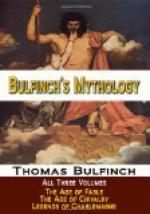The preparatory education of candidates for knighthood was long and arduous. At seven years of age the noble children were usually removed from their father’s house to the court or castle of their future patron, and placed under the care of a governor, who taught them the first articles of religion, and respect and reverence for their lords and superiors, and initiated them in the ceremonies of a court. They were called pages, valets, or varlets, and their office was to carve, to wait at table, and to perform other menial services, which were not then considered humiliating. In their leisure hours they learned to dance and play on the harp, were instructed in the mysteries of woods and rivers, that is, in hunting, falconry, and fishing, and in wrestling, tilting with spears, and performing other military exercises on horseback. At fourteen the page became an esquire, and began a course of severer and more laborious exercises. To vault on a horse in heavy armor; to run, to scale walls, and spring over ditches, under the same encumbrance; to wrestle, to wield the battle-axe for a length of time, without raising the visor or taking breath; to perform with grace all the evolutions of horsemanship,—were necessary preliminaries to the reception of knighthood, which was usually conferred at twenty-one years of age, when the young man’s education was supposed to be completed. In the meantime, the esquires were no less assiduously engaged in acquiring all those refinements of civility which formed what was in that age called courtesy. The same castle in which they received their education was usually thronged with young persons of the other sex, and the page was encouraged, at a very early age, to select some lady of the court as the mistress of his heart, to whom he was taught to refer all his sentiments, words, and actions. The service of his mistress was the glory and occupation of a knight, and her smiles, bestowed at once by affection and gratitude, were held out as the recompense of his well-directed valor. Religion united its influence with those of loyalty and love, and the order of knighthood, endowed with all the sanctity and religious awe that attended the priesthood, became an object of ambition to the greatest sovereigns.
The ceremonies of initiation were peculiarly solemn. After undergoing a severe fast, and spending whole nights in prayer, the candidate confessed, and received the sacrament. He then clothed himself in snow-white garments, and repaired to the church, or the hall, where the ceremony was to take place, bearing a knightly sword suspended from his neck, which the officiating priest took and blessed, and then returned to him. The candidate then, with folded arms, knelt before the presiding knight, who, after some questions about his motives and purposes in requesting admission, administered to him the oaths, and granted his request. Some of the knights present, sometimes even ladies and damsels, handed to him in succession the spurs,




